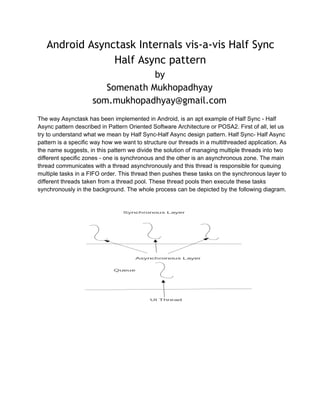
Android Asynctask Internals vis-a-vis half-sync half-async design pattern
- 1. Android Asynctask Internals vis-a-vis Half Sync Half Async pattern by Somenath Mukhopadhyay som.mukhopadhyay@gmail.com The way Asynctask has been implemented in Android, is an apt example of Half Sync Half Async pattern described in Pattern Oriented Software Architecture or POSA2. First of all, let us try to understand what we mean by Half SyncHalf Async design pattern. Half Sync Half Async pattern is a specific way how we want to structure our threads in a multithreaded application. As the name suggests, in this pattern we divide the solution of managing multiple threads into two different specific zones one is synchronous and the other is an asynchronous zone. The main thread communicates with a thread asynchronously and this thread is responsible for queuing multiple tasks in a FIFO order. This thread then pushes these tasks on the synchronous layer to different threads taken from a thread pool. These thread pools then execute these tasks synchronously in the background. The whole process can be depicted by the following diagram.
